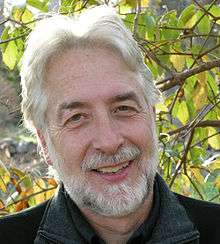Richard Gingras
| Richard Gingras | |
|---|---|
 Richard Gingras, 2011 | |
| Born |
Richard Louis Gingras January 17, 1952 Providence, Rhode Island, United States |
| Nationality | American |
| Alma mater | Boston College |
| Employer | |
| Board member of |
First Amendment Coalition International Center for Journalists World Computer Exchange |
| Spouse(s) | Mitzi Trumbo |
| Children | 2 |
Richard Gingras is an American Internet executive and entrepreneur, who has focussed on emerging digital media since 1979,[1] including efforts at Google, Apple Computer, Salon Media Group and the Public Broadcasting Service. Gingras has been an outspoken proponent for journalistic innovation on the Internet.[2][3][4]
Career
Gingras is currently vice president of news at Google.
Gingras was a key instigator in creating the Accelerated Mobile Pages (AMP) project which is an open-source effort to improve the speed of the World Wide Web and improve advertising user experience.[5][6] In late 2014, Gingras co-founded the Trust Project[7][8] with Sally Lehrman of the Markulla Center for Ethics at Santa Clara University. The Trust Project is a global effort of the journalism community to explore how the architecture of journalism can be enhanced to improve the perceived credibility of high-quality journalism.
Until July 2011, Gingras was CEO of Salon Media Group which operates the news site Salon.com and the pioneering virtual community The Well. Gingras has had a long association with Salon having assembled its initial seed financing in 1995. During 2007 and 2008, Gingras served as a strategic advisor to the executive team at Google focusing on strategies relating to the evolution of news and television.
In 2002, Gingras co-founded Goodmail Systems and served as its CEO and chairman. Goodmail Systems developed certified email services offered through large email providers including Yahoo and America Online. Gingras also served as interim president of MyPublisher from 2000-2001 and guided the design of a custom hardcover photo book service introduced by Apple Computer as part of iPhoto.
From early 1996 to mid 2000, Gingras led online service efforts at Excite@Home as Senior Vice President and General Manager of the company's consumer-focused product division, Excite Studios.
In January 1996, Gingras joined the early consumer broadband network @Home Network, as vice president of programming and editor-in-chief where he was responsible for the launch of @Home's broadband-enabled online portal. @Home was founded by the venture capital firm Kleiner Perkins in partnership with major US cable companies to offer high-speed Internet access.
At Apple Computer in the early 1990s Gingras led the development of the online service eWorld. A pre-Web online service, eWorld was considered innovative for its time, but it was expensive and failed to attract a high number of subscribers. The service was only available on the Macintosh, though a PC version had been planned. Following the merger of @Home with Excite, Gingras became Senior Vice President and General Manager of the company's consumer-focused product division, Excite Studios.
Gingras's work in interactive digital media began In 1979, when he produced one of the first interactive online news magazine which was delivered to several hundred test households using interactive television technology known as broadcast teletext. Gingras led the effort for the PBS service (KCET in Los Angeles) which also included service components for use in schools.
From 1987 to 1992, Gingras was the founder and president of MediaWorks, an Apple-funded startup that developed early news-agenting and executive support software for Fortune 500 corporations.
From 1983 to 1986, Gingras assembled and managed a network of television stations in the top fifty US markets to provide sideband data distribution for a news and advertising service, Silent Radio, that was presented on electronic displays in retail locations.
Boards and honors
Gingras serves on the boards of the First Amendment Coalition, the International Center for Journalists and the World Computer Exchange
In the fall of 2012, Gingras was recognized by Louisiana State University with the Manship Prize[9] for contributions to the evolution of digital media. In May 2013, Gingras gave the commencement speech at West Virginia University for the Reed School of Journalism.[10] In 2013, Gingras was a subject of the digital media oral history project[1] produced by the Joan Shorenstein Center on the Press, Politics and Public Policy at Harvard University.
References
- 1 2 Huey, John; Nisenholtz, Martin (April 1, 2014). "Riptide: An oral history of the epic collision between journalism and digital technology, 1980 to the present". Shorenstein Center on Media, Politics and Public Policy at Harvard University. Retrieved April 21, 2014.
- ↑ "Google's Gingras: 'The future of journalism can and will be better than its past.'". Poynter Institute. August 15, 2012. Retrieved May 3, 2014.
- ↑ Guimareas, Celia (May 6, 2014). "Richard Gingras and the evolution of the ecosystem of the news: 'We need to rethink everything'". Rai News24. Retrieved May 8, 2014.
- ↑ Ingram, Matthew (May 12, 2012). "Google's head of news: Newspapers are the new Yahoo". GigaOm. Retrieved May 2, 2014.
- ↑ Jarvis, Jeff (October 15, 2015). "To a Fast and Distributed Web: AMP HTML". Buzz Machine. Retrieved October 7, 2015.
- ↑ "Instant Everywhere". AMP Project. October 7, 2015. Retrieved October 7, 2015.
- ↑ Lehrman, Sally (October 16, 2014). "Online Chaos Demands Radical Action by Journalism to Earn Trust". Markkula Center for Ethics. Retrieved October 16, 2014.
- ↑ "Trust". Newsgeist Unconference 2014. November 14, 2014. Retrieved November 14, 2014.
- ↑ Louisiana State University Media Center (October 23, 2012). "Google's Gingras Honored with 2012 Manship Prize". Louisiana State University, Manship School of Mass Communications. Retrieved April 13, 2014.
- ↑ West Virginia University (May 18, 2013). "Perley Isaac Reed School of Journalism, 144th Commencement, West Virginia University". West Virginia University. Retrieved April 20, 2014.